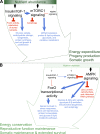Regulation of reproduction and longevity by nutrient-sensing pathways
- PMID: 29074705
- PMCID: PMC5748989
- DOI: 10.1083/jcb.201707168
Regulation of reproduction and longevity by nutrient-sensing pathways
Abstract
Nutrients are necessary for life, as they are a crucial requirement for biological processes including reproduction, somatic growth, and tissue maintenance. Therefore, signaling systems involved in detecting and interpreting nutrient or energy levels-most notably, the insulin/insulin-like growth factor 1 (IGF-1) signaling pathway, mechanistic target of rapamycin (mTOR), and adenosine monophosphate-activated protein kinase (AMPK)-play important roles in regulating physiological decisions to reproduce, grow, and age. In this review, we discuss the connections between reproductive senescence and somatic aging and give an overview of the involvement of nutrient-sensing pathways in controlling both reproductive function and lifespan. Although the molecular mechanisms that affect these processes can be influenced by distinct tissue-, temporal-, and pathway-specific signaling events, the progression of reproductive aging and somatic aging is systemically coordinated by integrated nutrient-sensing signaling pathways regulating somatic tissue maintenance in conjunction with reproductive capacity.
© 2018 Templeman and Murphy.
Figures



Similar articles
-
Macronutrients and caloric intake in health and longevity.J Endocrinol. 2015 Jul;226(1):R17-28. doi: 10.1530/JOE-15-0173. Epub 2015 May 28. J Endocrinol. 2015. PMID: 26021555 Free PMC article. Review.
-
Lessons from C. elegans: signaling pathways for longevity.Trends Endocrinol Metab. 2012 Dec;23(12):637-44. doi: 10.1016/j.tem.2012.07.007. Epub 2012 Aug 30. Trends Endocrinol Metab. 2012. PMID: 22939742 Free PMC article. Review.
-
Nutrient Sensing, Signaling and Ageing: The Role of IGF-1 and mTOR in Ageing and Age-Related Disease.Subcell Biochem. 2018;90:49-97. doi: 10.1007/978-981-13-2835-0_3. Subcell Biochem. 2018. PMID: 30779006 Review.
-
Conservative growth hormone/IGF-1 and mTOR signaling pathways as a target for aging and cancer prevention: do we really have an antiaging drug?Interdiscip Top Gerontol. 2015;40:177-88. doi: 10.1159/000364982. Epub 2014 Oct 13. Interdiscip Top Gerontol. 2015. PMID: 25341521 Review.
-
Longevity Pathways (mTOR, SIRT, Insulin/IGF-1) as Key Modulatory Targets on Aging and Neurodegeneration.Curr Top Med Chem. 2015;15(21):2116-38. doi: 10.2174/1568026615666150610125715. Curr Top Med Chem. 2015. PMID: 26059361 Review.
Cited by
-
PTEN: A Thrifty Gene That Causes Disease in Times of Plenty?Front Nutr. 2020 Jun 5;7:81. doi: 10.3389/fnut.2020.00081. eCollection 2020. Front Nutr. 2020. PMID: 32582754 Free PMC article.
-
Sex-biased gene expression in nutrient-sensing pathways.Proc Biol Sci. 2023 Mar 8;290(1994):20222086. doi: 10.1098/rspb.2022.2086. Epub 2023 Mar 8. Proc Biol Sci. 2023. PMID: 36883280 Free PMC article.
-
ATGL-1 mediates the effect of dietary restriction and the insulin/IGF-1 signaling pathway on longevity in C. elegans.Mol Metab. 2019 Sep;27:75-82. doi: 10.1016/j.molmet.2019.07.001. Epub 2019 Jul 5. Mol Metab. 2019. PMID: 31311719 Free PMC article.
-
Molecular Regulation of Fetal Brain Development in Inbred and Congenic Mouse Strains Differing in Longevity.Genes (Basel). 2024 May 9;15(5):604. doi: 10.3390/genes15050604. Genes (Basel). 2024. PMID: 38790233 Free PMC article.
-
Too old for healthy aging? Exploring age limits of longevity treatments.NPJ Metab Health Dis. 2024;2(1):37. doi: 10.1038/s44324-024-00040-3. Epub 2024 Dec 12. NPJ Metab Health Dis. 2024. PMID: 39678297 Free PMC article. Review.
References
Publication types
MeSH terms
Substances
Grants and funding
LinkOut - more resources
Full Text Sources
Other Literature Sources
Medical
Miscellaneous

